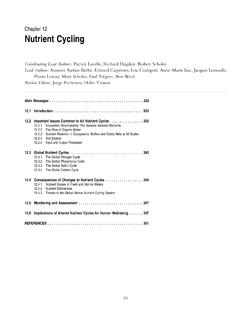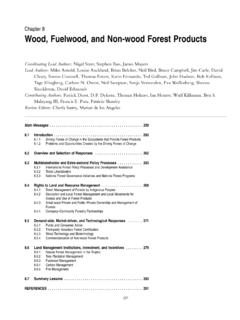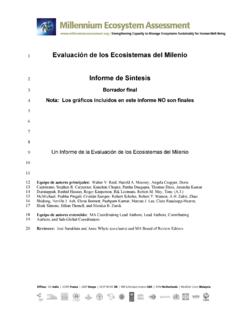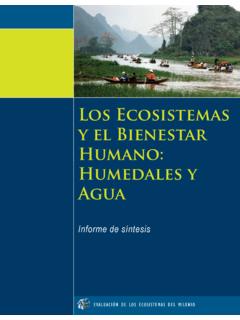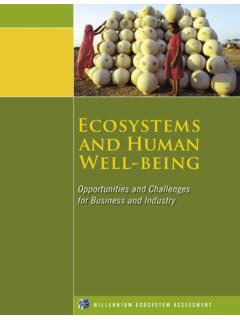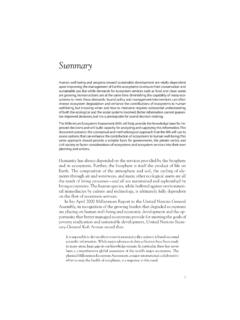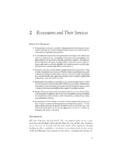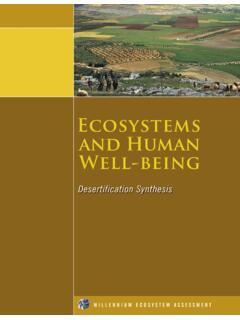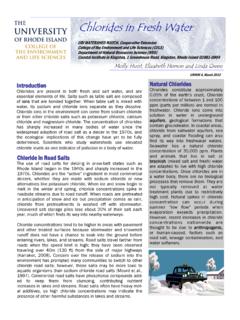Transcription of Chapter 7 Fresh Water - Millennium Assessment
1 Chapter 7. Fresh Water Coordinating Lead Authors: Charles J. Vo ro smarty, Christian Le ve que, Carmen Revenga Lead Authors: Robert Bos, Chris Caudill, John Chilton, Ellen M. Douglas, Michel Meybeck, Daniel Prager Contributing Authors: Patricia Balvanera, Sabrina Barker, Manuel Maas, Christer Nilsson, Taikan Oki, Cathy A. Reidy Review Editors: Frank Rijsberman, Robert Costanza, Pedro Jacobi Main Messages .. 167. Introduction to Fresh Water as a Provisioning Service .. 168. Fresh Water in the MA Context Setting the Stage Distribution, Magnitude, and Trends in the Provision of Fresh Water .. 170. Available Water Supplies for Humans Water Use The Notion of Water Scarcity Environmental Flows for Ecosystems Water Quality Drivers of Change in the Provision of Fresh Water .
2 181. Population Growth and Development Managed Water Supplies Land Use and Land Cover Change Climate Change and Variability Urbanization Industrial Development Consequences for Human Well-being of Changes in the Provision of Fresh Water .. 190. freshwater Provision: Benefits and Investment Requirements Consequences of Water Scarcity The Cost and Pricing of Water Delivery Consequences of Too Much Water : Floods Consequences of Poor Water Quality on Human Health Trade-offs in the Contemporary Use of freshwater Resources .. 197. REFERENCES .. 201. 165. 166 Ecosystems and Human Well-being: Current State and Trends BOXES Time Series of Renewable Water Supply across the Global Operational Definitions of Key Terms on Fresh Water Landmass since 1920.
3 Ministerial Declaration from the 2nd World Water Forum Proportion of Population with Improved Drinking Water Supply, 2002*. Uncertainties in Estimates of Contemporary freshwater Services, Use, and Scarcity Proportion of Population with Improved Sanitation Coverage, 2002*. Virtual Water Content Associated with African Food Supply Trade-off Analysis, Depicting Major Interventions and Defining Improved Water Supply and Sanitation Consequences on Condition of Ecosystems and FIGURES Development Goals Global Renewable Water Supply as River Discharge and TABLES. Populations Dependent on Accessible Runoff at Point of Major Storages Associated with the Contemporary Global Origin*.
4 Water System Cumulative Distribution of Population with Respect to Estimates of Renewable Water Supply, Access to Renewable freshwater Services, 1995 2000. Supplies, and Population Served by the Provision of Contemporary Geography of Non-sustainable Withdrawals freshwater Services, Year 2000 Condition for Irrigation*. freshwater Services Tabulated as Withdrawals for Human Managing for Environmental Flows: Contrasts among Use over MA Regions and the World, 1995 2000. Natural, Reservoir-affected, and Reconstituted River Consumptive and Non-sustainable freshwater Use over MA. Discharge Regimes Regions and the World, 1995 2000. Contrast between Mid-1990s and Pre-disturbance Transports Indicators of freshwater Provisioning Services and Their of Total Nitrogen through Inland Aquatic Systems Resulting Historical and Projected Trends, 1960 2010.
5 From Anthropogenic Acceleration of This Nutrient Cycle*. Data Assessment of Existing Monitoring Programs Worldwide Global Summary of Inorganic Nitrogen Transport by Contemporary Rivers Continental-scale Assessment of Major Water Quality Issues Ranking of Globally Significant Water Quality Issues Affecting Annual Transfer of Virtual and Real Water through Global the Provision of freshwater Services for Water Resource Trade of Cereal and Meat Commodities, 2000. End Uses Brief Overview of Hydrologic Consequences Associated with Time Series of Intercepted Continental Runoff and Large Major Classes of Land Cover and Use Change Reservoir Storage, 1900 2000 Selected Water -Related Diseases Net Inter-regional Trade in Major Crops Expressed as Access to Clean Water and Sanitation Embodied or Virtual'' Water Expended in Production of Regional Progress toward the MDG Sanitation Goal These Agricultural Commodities, 1995 99.
6 Major Objectives Optimized in Experiments to Discern the Percentage of Cropland Area by River Basin* Compatibility of Development Goals and International Percentage Urban and Industrial Land Use by River Basin* Conventions *This appears in Appendix A at the end of this volume. Fresh Water 167. Main Messages The supply of Fresh Water continues to be reduced by severe pollution from anthropogenic sources in many parts of the world. Over the past Global freshwater use is estimated to expand 10% from 2000 to 2010, half-century, there has been an accelerated release of artificial chemicals into down from a per decade rate of about 20% between 1960 and 2000.
7 These the environment. Inorganic nitrogen pollution of inland waterways, for example, rates reflect population growth, economic development, and changes in has increased substantially, with nitrogen loads transported by the global sys- Water use efficiency. Projections that this trend will continue have a high tem of rivers rising more than twofold over the preindustrial state. Increases of degree of certainty. Contemporary Water withdrawal is approximately 3,600 more than tenfold are recorded across many industrialized regions of the world. cubic kilometers per year globally or 25% of the continental runoff to which the Many anthropogenic chemicals are long-lived and transformed into by-products majority of the population has access during the year.
8 If dedicated instream whose behaviors, synergies, and impacts are for the most part unknown as uses for navigation, waste processing, and habitat management are consid- yet. As a consequence of pollution, the ability of ecosystems to provide clean ered, humans then use and regulate over 40% of renewable accessible sup- and reliable sources of Fresh Water is impaired. Severe deterioration in the plies. Regional variations from differential development pressures and quality of Fresh Water is magnified in cultivated and urban systems (high use, efficiency changes during 1960 2000 produced increases in Water use of 15 high pollution sources) and dryland systems (high demand for flow regulation, 32% per decade.)
9 Absence of dilution potential). Four out of every five people live downstream of, and are served by, The demand for reliable sources of Fresh Water and flood control has renewable freshwater services, representing 75% of the total supply. Be- encouraged engineering practices that have compromised the sustain- cause the distribution of Fresh Water is uneven in space and time, more than 1 ability of inland Water systems and their provision of freshwater services. billion people live under hydrologic conditions that generate no appreciable Prolific dam-building (45,000 large dams and possibly 800,000 smaller ones). supply of renewable Fresh Water . An additional 4 billion (65% of world popula- has generated both positive and negative effects.
10 Positive effects on human well-being have included flow stabilization for irrigation, flood control, drinking tion) is served by only 50% of total annual renewable runoff that is positioned Water , and hydroelectricity. Negative effects have included fragmentation and in dry to only moderately wet conditions, with concomitant pressure on that destruction of habitat, loss of species, health issues associated with stagnant resource base. Only about 15% live with relative Water abundance. Water , and loss of sediments and nutrients destined to support coastal ecosys- tems and fisheries. Forest and mountain ecosystems serve as source areas for the largest amounts of renewable freshwater supply 57% and 28% of total runoff, Water scarcity is a globally significant and accelerating condition for 1 2.
